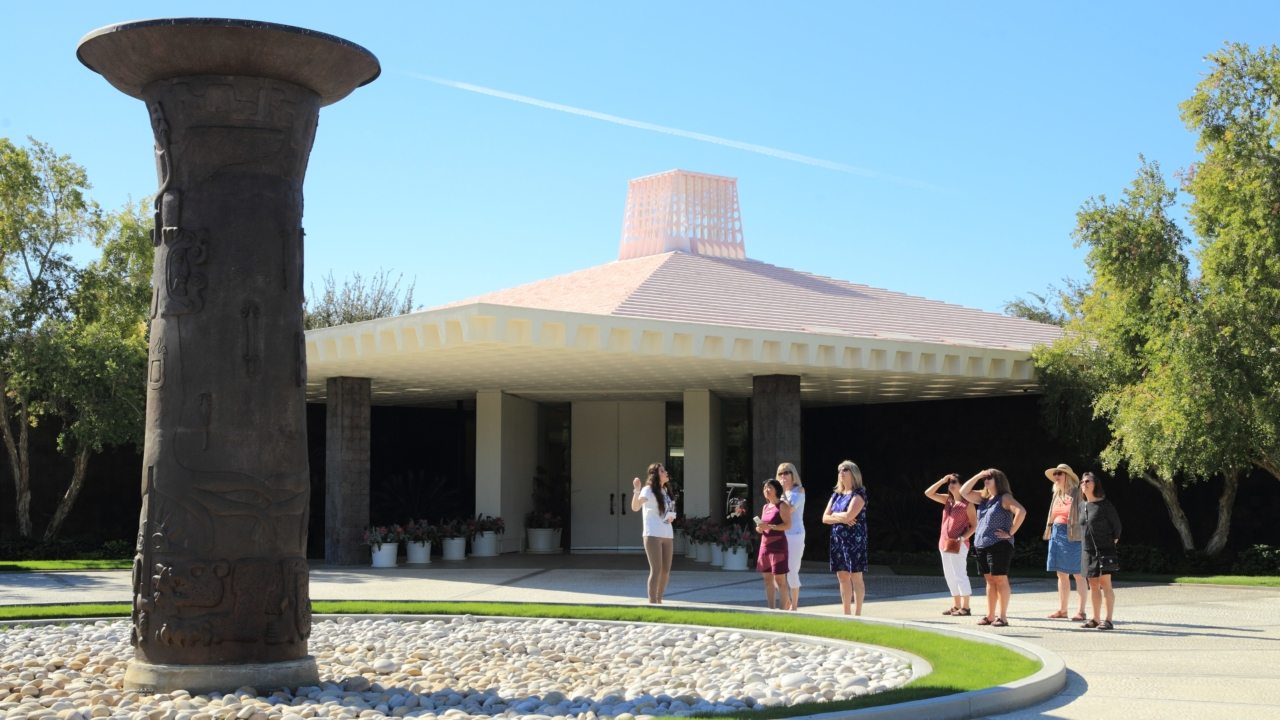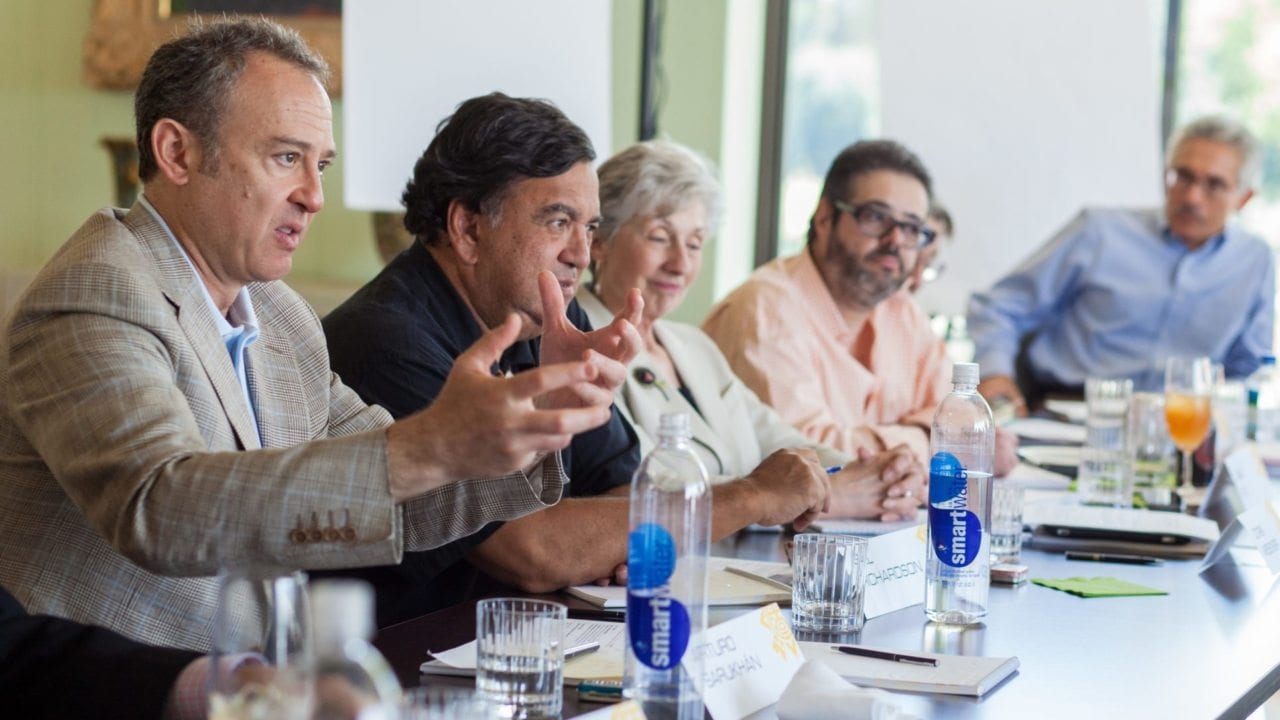The State of the Arts in America
This paper was delivered on March 19, 2015 by Michael M. Kaiser, the former president of John F. Kennedy Center for the Performing Arts. Kaiser is currently president of the DeVos Institute at the University of Maryland, and co-chairman of IMG Artists, the performing arts management agency.
It is a great pleasure to be at Sunnylands today to discuss the challenges facing arts institutions in a rapidly changing environment. It is particularly poignant for me to be speaking on a program that includes the work of three of my favorite artists and friends: Renee Fleming, David Hallberg and Quincy Jones, and the visionary Phillipe Jordan. With artists like these working today, one has to feel good about the state of the arts in America.
Private Philanthropy vs. Government Subsidies
While most nations have relied on government support for the arts, there remain almost no governments that can afford to meet fully the dreams of their artists.
Government leaders on every continent now believe that some form of private philanthropy will be crucial in their nations and they look to the American model for answers. We, of course, do not enjoy high levels of direct government support for the arts. The Puritans who founded our nation believed music and dance were evil and that has led to a separation of art and state that has endured to this day.
We have relied instead on an ever-growing number of citizen-philanthropists. The Metropolitan Opera was founded in 1883 by a small group of families who could not get box seats at the Academy of Music.
Today the Metropolitan Opera must raise hundreds of millions of dollars each year from tens of thousands of donors to balance its budget. And the Met is but one of 100,000 American not-for-profit arts institutions looking for funding.
I have had the opportunity to experience first-hand the difference between the American and European systems of arts funding. I have run the Kansas City Ballet, Alvin Ailey American Dance Theater, American Ballet Theatre, and the Kennedy Center here in the United States and also have had the honor of serving as executive director of the Royal Opera House in London, England.
While the average arts organization in the United States receives less than 10 percent of its funding from all levels of government, the figure in England has traditionally been closer to 30 percent, and in continental Europe closer to 70 percent.
And while American arts leaders often dream of receiving such a large government subsidy, I can attest that there are advantages and disadvantages to both systems. The large government subsidy does make artistic planning easier since subsidies have, at least in the past, been guaranteed. If one knows how much subsidy you are going to receive, you can plan for larger, future projects with some sense of security.
Arts organizations could also be headed by artists with clear aesthetic visions since there was little pressure to mount large marketing and fundraising campaigns. They could take more artistic risk since they relied less on box office revenue and private donations.
The subsidy also allowed many tickets to be cheaper, so more segments of the community could enjoy the arts.
But the American system has advantages as well. Our focus has to be on the customer – both the ticket buyer and the donor, so our work tends to speak more directly to our audience.
And while European arts leaders worry about the power of private donors, how they might dictate repertory for example, I can truthfully say that I have never had a donor as potent as the British government.
But the biggest advantage of our system is that we are not as affected by political and economic swings. Many American arts donors remain loyal even during bad economic periods; and since government funding plays a smaller role here, a reduction in funding levels by a national, state, or local funding agency – for economic or political reasons – doesn’t have a huge impact on most organizations.
Arts organizations in virtually every European country, however, are now facing large cuts in their government subsidies as other funding needs take priority and as the economy has soured. Arts leaders in France, Germany, Italy, and Spain — all bastions of Western culture- – simply do not know how to respond. They have never had to do much fundraising and building a fundraising effort quickly and effectively is not simple. (By the way, even the arts organizations in our country that have traditionally had the greatest challenges raising private funds–organizations of color and rural organizations– suffer the most when government funding is cut as it has been over the past ten years, particularly at state and local levels.)
But I remain optimistic that arts organizations in any country can build a successful fundraising activity. When I arrived at the Royal Opera House in 1998 we were facing a $30 million deficit, and we were completing a massive renovation of our facility. We simply did not have the money to finish the building, and I had to expand our fundraising effort overnight. There were many skeptics who believed we could not succeed, but, in fact, we raised $100 million in 18 months, a large sum for England or any European country. In the end, people are people and the way we make giving fun and rewarding in the United States also works in other nations. But there is no true culture of giving in most other nations. And my peers running organizations in other nations are so envious of the generosity of the American people and, especially, the involvement of our board members.
Americans are, of course, the most generous people in the world. We had to be or we would not have had the remarkable quilt of arts institutions that we enjoy in this nation not to mention the hospitals and universities that serve us so well.
Six years ago, immediately following the stock market crash, I embarked on a 69-city, 50-state tour of the United States talking to arts groups about the economic crisis, approaches to addressing the crisis, and pitfalls to avoid.
I learned a great deal from the artists, arts managers, board members, and politicians across this great nation and observed trends and patterns in arts funding and the challenges arts institutions have in finding resources.
First, and most important, I observed the vitality of the arts in our nation. In every city I visited, there are theater companies, orchestras, dance companies, and museums creating important work for their communities. From Bismarck, North Dakota, to Meridien, Mississippi, Anchorage, Alaska, to Charlotte, North Carolina, there are vibrant artists, arts organizations, and arts educators inspiring their constituents. I was struck by the remarkable level of generosity of donors – large and small – in every city I visited. Anyone who believes that the arts are not a central part of the lives of Americans, or who question if there is enough interest to fund the arts, should take the time to visit the cities I was lucky enough to see on my tour.
The arts have proved remarkably resilient during the economic downturns of the 21st century. In 2009 there were predictions that 10,000 of our 100,000 not-for-profit arts organizations would go bankrupt during the recent recession. The truth is nowhere near that number succumbed. Arts organizations have learned to be flexible, to do a great deal with very little and to cope with less.
Arts groups belong to an amazingly tough industry in large measure because of the diversity of funding sources we cultivate. But while I am a fan of our system of arts funding and so proud of the remarkable amount of art in our nation, I am also deeply concerned for the continued health of our arts ecology.
There are five key reasons for my anxiety about the future of the arts in this nation.
First, I am concerned about the quality of the art itself. I have observed that the creativity has been beaten out of so many artists and arts organizations.
Everyone is so concerned about money and “what sells” that we have gotten too conservative with our art-making.
Producing boring art is the surest way to create fiscal problems because our audiences and donors look elsewhere. Especially with so many online entertainment options available today, there are plenty of places to look. And with many of the world’s largest arts institutions – the Metropolitan Opera and the Bolshoi Ballet and the Royal Shakespeare Company and others – broadcasting their performances to movie theaters and to home computers with increasing frequency, it will be far harder for regional arts institutions to compete for audiences unless their art is astonishing.
Of course many arts organizations are creating dynamic arts projects – from the San Francisco Symphony to ArtPrize in Grand Rapids, from the new World Symphony in Miami, to Glimmerglass Festival in Cooperstown, New York. But too many organizations think they can remain healthy by producing safe art and too many arts organizations spend more time talking about money than about creativity.
We don’t just worry about money too much; we even talk about it too much. We must remember that our function is to inspire, entertain, and educate our communities.
We have spent so much time complaining about our plight and focusing on our financial challenges that many people do not want to interact with us anymore. They have come to us for respite but we have not been as accommodating as we need to be. There were more national headlines about arts organizations in financial distress in recent years – from the Minnesota Orchestra to the Metropolitan Opera to the Atlanta Symphony – than about arts innovation or excellence.
We talk about money in the press, to our audiences, to our donors, and especially to our board members. Our board meetings are almost entirely devoted to discussions of cash flow and income statements. We forget to discuss what we do for our communities, how much fun it is to come to an exhibition or performance, or how we educate our children to be creative thinkers. Then we are surprised that board members stay away and, worse, do not introduce us to their friends and associates.
We must return our focus to our contributions to the community; few people really care about our problems. They have problems of their own.
Arts Marketing should be programmatic marketing
My second concern is that arts organizations simply are not doing a good enough job of marketing. We have a lot to learn from the sports world. Sports leagues do a great job of engaging people through their marketing activities. They don’t just sell tickets; they encourage a relationship between the individual fan and the team as a whole. And these fans repay them by spending a great deal on tickets and souvenirs, food and parking.
Too many people believe arts marketing is only about selling tickets. So their marketing efforts focus on advertisements, direct mail, email blasts, etc. These activities, which do help create earned income, I call programmatic marketing. Arts organizations have done a good job of creating programmatic campaigns though I observe that too many do not differentiate enough between the marketing needs of different types of programs. Most arts organizations have a template for marketing every project: they do three advertisements, a direct mail post card, a radio spot, and two email blasts, for example.
But some programs require almost no marketing to sell out: Yo-Yo Ma in concert, for example. Others require a great deal more information, a new play by an unknown author, for example.
These more challenging ventures need what I term missionary marketing. They require much more detailed explanations than can be accommodated by a poster or simple advertisement. We must save money on marketing the first type of program to invest in the second. And we must appreciate that online activities are our new best friends in creating visibility and educating audiences. We can reduce the amount we spend on programmatic marketing by using email, websites, social networking sites, etc., to their full potential. People are getting their information in new ways – that is why newspapers are going bankrupt – and we must recognize it.
But we must also invest in a second type of marketing, institutional marketing, that creates excitement for our organizations as a whole.
Shortly after I arrived at the Alvin Ailey American Dance Theater, the world’s largest modern dance company, the author Alex Hailey died. We received hundreds of letters of condolence because people thought Alex Hailey was Alvin Ailey. I realized we had a major image problem if people thought we wrote Roots in our dance studios. So we embarked on a substantial institutional marketing campaign that included appearances on the Phil Donahue show and at President Clinton’s first inaugural gala, an exhibition at the Smithsonian in Washington, a free concert in Central Park, the naming of our street in New York City as Alvin Ailey Place, the publication of two books about the organization and a huge gala celebrating our 35th anniversary with Jessye Norman, Al Jarreau, Dionne Warwick, Denzel Washington, Maya Angelou, and many others.
Over a 12-month period, everywhere you turned there was the Ailey Company doing something exciting. Not one of these events changed the history of the Ailey organization. But taken as a package, we created a new level of excitement and understanding about the organization.
Not surprisingly, ticket sales and tour invitations increased while programmatic marketing costs fell. But more important, our fundraising doubled in one year, and we were able to pay off the entire historic deficit of the organization in 1993.
Why did fundraising increase? Because as they learned about the vibrancy of Ailey, more people wanted to be attached to the organization, as donors, volunteers, and board members. Our institutional family grew considerably in 1993.
But more important, our board members were so proud of the organization that they wanted to involve their friends and associates. When I arrived at Ailey, and we were virtually bankrupt, I met with each of our 36 board members and asked who they knew who could help us. Surprisingly, not one board member had ever met another human being.
After we mounted our institutional marketing campaign our board members seemed to have met thousands of friends they wanted to bring into the Ailey family.
This is one of the most important by products of institutional marketing. It helps to erase the embarrassment that many board members feel about us. This embarrassment school of board membership is rife. So many board members love their organizations but are embarrassed to involve friends because of tremendous financial problems, board bullies who dominate meetings, typos in thank you letters, etc.
What I learned from my Ailey experience is that to get a board to participate fully we must make them unembarrassed. Great programming supported by great institutional marketing is the key to doing so.
Many people believe that only large, famous organizations can do institutional marketing. Many people on my U.S. tour were amused by my stories but did not believe they could do institutional marketing for their organizations. Yet I implemented an institutional marketing program at the Kansas City Ballet, a mid-sized ballet company in Kansas City, Missouri, in the mid-198os. When I arrived at the organization, we had a tag line: the company that can’t meet payroll. I knew I had to change this reputation.
So we put a television news anchor from the local NBC affiliate on our board. His board contribution was to put us on his show four times a year. We also negotiated a debut tour to NYC, mounted a ballet by George Balanchine that had not been danced in over 20 years, built a relationship with the Alvin Ailey organization, appeared three times a year on an early morning television talk show, created a gala featuring our dancers and major ballet stars from the largest companies in the world, and on and on.
We paid off our entire historic deficit with the extra revenue earned in just ten months.
Importantly, most of these activities for the Kansas City Ballet and Ailey did not cost us a penny. Rather, it took time and creativity and using the relationships we had farmed in an entrepreneurial fashion.
Arts Education Leads to new, engaged audiences
My third concern relates to the ages of our audience members and donors. It is almost trite to say that our audiences are too old. In fact, that has been true for over a century.
But we now face a different situation.
While one can read accounts from the 1890s that arts patrons are too old, for a century we enjoyed a constant replenishment of our supporters.
American children were introduced to the arts by their parents but also in schools. I can remember a time when every child had a chance to sing in a chorus, perform a school play, play an instrument, and learn to paint. Most children, although not all, stopped their arts participation when they hit high school and began thinking about dating, college, marriage, careers, and families. Most people did not resume arts participation until middle age, when careers were underway, children were grown and they had more discretionary time and money.
So while our audiences were older than the population in general, we had a constant replenishment of audience, donors, board members, and volunteers.
But today we have so little organized arts education in our schools that I am not so certain that as the current generation of school children ages, they will find their way to the arts if they didn’t have them as a child. If not, who will be our audience members and donors of the future? In fact, I am far more concerned for the arts 20 years from now than I am about the current economic challenges we face. That is why I just published a new book, Curtains: The Future of the Arts in America that describes the way the arts in this country will evolve if we do not change prevailing patterns of behavior by our arts institutions.
And while there is far too little arts education in our schools, even the education programs we do have are not substantial enough. They are disjointed, episodic, and not very potent. That is because we leave the purchase decision for arts events to the individual teacher. If a third grade teacher loves the arts, the children in the class will get many arts experiences: they will visit a museum, produce a class play, learn from a teaching artist, etc. But when these same children get to fourth grade, they may have no arts if their teacher does not care about them. We do not teach any other subject that way.
Imagine if your children or grandchildren came home and said they were not learning math this year because their teacher didn’t like it. But that is the way we teach the arts.
So when I headed the Kennedy Center, we developed a new program, Any Given Child, that created a systematic arts education in every grade from kindergarten through 8th grade in a given city by organizing the activities of the schools and the arts organizations in that community into a coherent, curriculum-based program. This program is installed now in fifteen American cities with over one million students – from Sacramento, California, to Baltimore, Maryland. The program is tailored to the needs of each location.
For example, every 4th grader in Sacramento studies Latino culture so every child in the fourth grade in the school system there now works with the local Latino Cultural Center. Every child in these cities will receive a coordinated, consistent arts education.
But we need other arts organizations and school systems to follow suit.
Board members have five key functions
My fourth major concern for the health of the arts relates to boards of arts organizations. Too many board members simply do not know enough about what creates health in the arts. While they approach their board duties with tremendous generosity of time, spirit and resources, they make decisions that are not necessarily in the best interests of their organizations. The most common mistakes include cutting art and marketing to balance the budget (when art and marketing are the very reasons people support us), believing that building an endowment will cure everything, suggesting that safe art is the easiest art to support and not forcing their executives to plan art early enough to help attract new donors.
We need board members who know how to perform the five key functions of boards: developing and approving plans, understanding and approving the annual budget, hiring, firing, compensating and motivating their direct reports, participating actively in gathering resources, and serving as ambassadors in the community.
We also need boards to be vigilant about evaluating their own membership to ensure that the current group of trustees is the right group for the next few years. When I arrived at Alvin Ailey in 1991, almost half my board had been trustees for 33 years. They had sewn the original costumes and driven the dancers to the first performances in 1958. They were remarkable, wonderful, passionate people but they were not the appropriate governors for the organization at that moment in our history. Our budget was $6.5 million but the combined giving of half of our board of 36 members was $5, 000. No wonder we were going bankrupt. Arts organizations have a life cycle, and board composition must change as the organization matures. When an arts organization is founded, the board acts like quasi-staff. They may do the bookkeeping, do the marketing, and even sew the costumes. But as the organization grows and matures, it hires staff to fill these functions and needs its board to be more active in raising funds.
Arts boards that do the best job of evaluating and changing their own compositions are typically the healthiest ones in our nation.
Art Managers Need Training, too
While boards require training, arts managers need it too. My last major concern is that arts managers simply do not have the training they need to deal with the range of challenges I have addressed today. And that takes us back where we began, to the DeVos Institute of Arts Management at the University of Maryland.
The Institute addresses my belief that the greatest problem facing the arts today is not a shortage of great composers, choreographers, or playwrights, but rather a serious deficit in trained managers to employ and support these artists. Arts management is a very young field, and too many arts managers and board members simply do not know how to build the levels of support needed to makes artists’ dreams come true.
The field needs its sophisticated donors to encourage, and might I say force, our arts managers to learn how to plan for important art, well in advance, to pursue sophisticated aggressive marketing campaigns, to create meaningful arts education programs, and to encourage board members to fulfill their responsibilities effectively.
Without strong leadership, the arts will not be able to create the artistic and educational programming that is so vital for our communities.
Without strong leadership, our arts organizations will not build the large, engaged families of audience members and donors we need to stay healthy.
Without strong leadership, we will not build the future generations of arts lovers and arts leaders.
And without strong leadership, our system of arts funding will not sustain the remarkable arts ecology this nation has created. We are so fortunate to have the freedoms we have to create art and arts institutions in the United States of America.
But with this freedom comes the responsibility to do it well.



